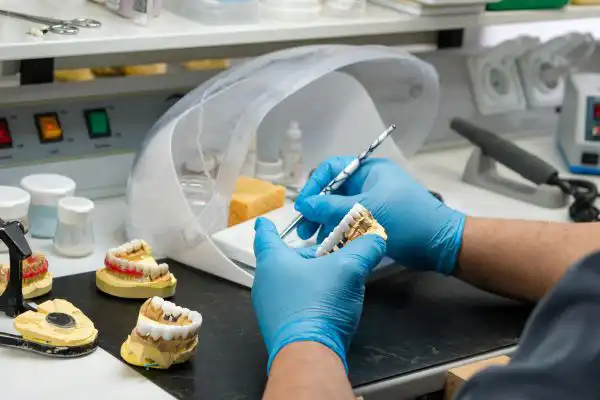Prosthodontics
Table of Contents
What is Prosthodontics?
Prosthodontics is a specialized field of dentistry dedicated to restoring and enhancing the smiles of countless individuals. This comprehensive guide will take you on a journey through the intricate world of Prosthodontics, shedding light on its various aspects, techniques, and innovations. From understanding the basics to delving into advanced procedures, this article is your gateway to the world of dental restoration.

Prosthodontics: The Essence
Prosthodontics is not just about fixing teeth; it’s about transforming lives. It focuses on the art and science of restoring oral function, appearance, and overall health.
The Role of a Prosthodontist
A Prosthodontist is a dental specialist with advanced training in the restoration and replacement of teeth. They are the architects of your smile, ensuring that form and function harmonize seamlessly.
The Journey to a Radiant Smile
Achieving a dazzling smile often involves a series of steps, each crucial to the end result.
1. Diagnosis and Treatment Planning
Before embarking on any dental restoration journey, a Prosthodontist conducts a comprehensive evaluation of your oral health. This phase lays the foundation for personalized treatment plans.
2. Restoring Missing Teeth
Dental Implants: A Lifelike Solution
Dental implants are a revolutionary advancement in Prosthodontics. These titanium wonders serve as artificial tooth roots, providing a stable foundation for crowns, bridges, and dentures.
3. Crowning Glory
Crowns: Reinventing Your Teeth
Crowns are custom-made caps that cover damaged or discolored teeth. They not only enhance aesthetics but also strengthen the tooth structure.
4. Bridging the Gap
Bridges: Filling Spaces
Dental bridges are an effective way to replace missing teeth. They bridge the gap between healthy teeth, restoring both function and appearance.
5. Embracing Dentures
Dentures: A Time-Tested Solution
Dentures have come a long way. Modern dentures are comfortable, natural-looking, and a lifeline for those with multiple missing teeth.
Definition of Dental Terminology
Prosthodontics
Prosthodontics is a branch of dentistry that focuses on the design, manufacture, and fitting of artificial replacements for teeth and other oral structures, including crowns, bridges, dentures, and dental implants.
Dental Prosthesis
A dental prosthesis is an artificial device or appliance used to replace missing teeth or other oral structures. Examples include dentures, bridges, and dental implants.
Denture
A denture is a removable dental prosthesis that replaces missing teeth and surrounding tissues. It can be full (replacing all teeth) or partial (replacing some teeth).
Bridge
A dental bridge is a fixed prosthesis used to replace one or more missing teeth. It consists of crowns on the natural teeth (abutments) with artificial teeth (pontics) suspended between them.
Dental Implant
A dental implant is a titanium post surgically placed into the jawbone to serve as an artificial tooth root. It can support a crown, bridge, or denture.
Crown
A dental crown is a cap-like restoration that covers and protects a damaged or weakened tooth. It can also be used to improve the appearance of a tooth.
Abutment
In the context of dental implants, an abutment is a connector that attaches to the implant and supports a crown, bridge, or denture.
Pontic
A pontic is an artificial tooth used in a bridge to replace a missing natural tooth. It is suspended between the abutments.
Complete Denture
A complete denture is a removable prosthesis that replaces all of the teeth in one or both dental arches (upper or lower).
Partial Denture
A partial denture is a removable prosthesis used to replace some missing teeth when some natural teeth are still present.
Overdenture
An overdenture is a removable prosthesis that fits over retained natural teeth or dental implants to provide stability and support.
Prosthodontist
A prosthodontist is a dentist who specializes in the field of prosthodontics and is trained to diagnose, plan, and provide prosthodontic treatment.
Impression
An impression is a mold or replica of a patient’s teeth and oral tissues, which is used to create custom-fitted dental prostheses.
Occlusion
Occlusion refers to the alignment and contact between the upper and lower teeth when the jaws are closed. Proper occlusion is essential for effective chewing and comfort.
Articulator
An articulator is a mechanical device used by prosthodontists and dental technicians to simulate the movement and position of the jaw when designing dental prostheses.
Frequently Asked Questions
A dental implant procedure can vary in duration depending on the complexity. On average, it takes between three to six months for the implant to integrate with the jawbone fully.
No, crowns and veneers are not the same. While both improve the appearance of teeth, crowns encase the entire tooth, while veneers cover only the front surface.
Yes, implant-supported dentures are a popular choice. They provide stability and prevent the slipping and discomfort often associated with traditional dentures.
Prosthodontics can benefit people of all ages. It is not limited to adults and can address various dental issues in children and adolescents as well.
After getting a dental bridge, some initial discomfort and sensitivity are common. However, these symptoms usually subside within a few days to a week.
Yes, you can eat most foods with dentures. However, initially, it’s best to stick to soft foods and gradually reintroduce harder foods as you become accustomed to your dentures.
